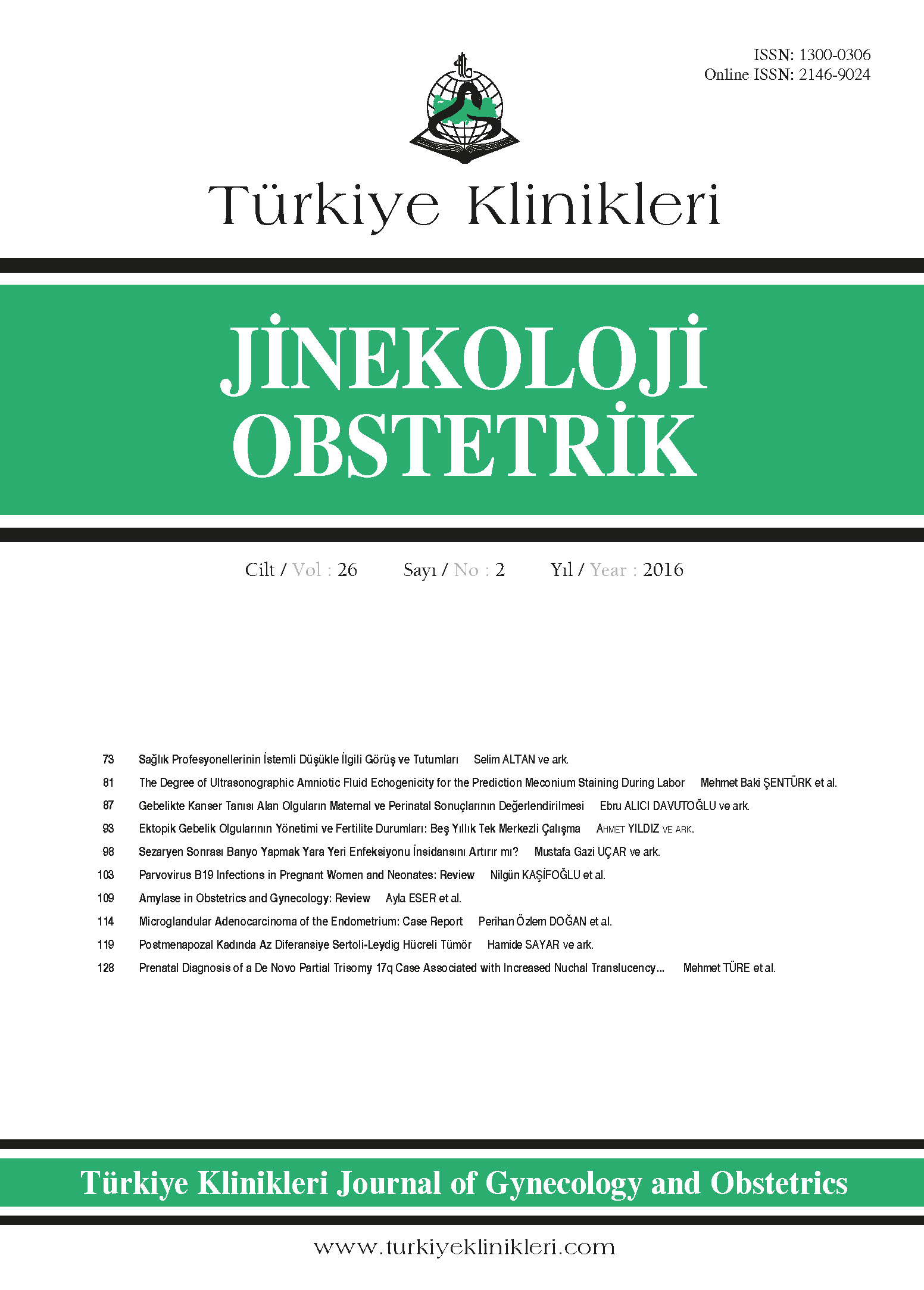Open Access
Peer Reviewed
REVIEW
3046 Viewed1573 Downloaded
Parvovirus B19 Infections in Pregnant Women and Neonates: Review
Gebe Kadınlarda ve Yenidoğanlarda Parvovirus B19 Enfeksiyonları
Turkiye Klinikleri J Gynecol Obst. 2016;26(2):103-8
DOI: 10.5336/gynobstet.2013-38434
Article Language: EN
Article Language: EN
Copyright Ⓒ 2025 by Türkiye Klinikleri. This is an open access article under the CC BY-NC-ND license (http://creativecommons.org/licenses/by-nc-nd/4.0/)
ABSTRACT
Parvovirus B19 was discovered by Cossart et al. in 1975 incidentally while screening sera for hepatitis B surface antigen by electron microscopy. Parvovirus B19 is a nonenveloped, small, single-stranded DNA virus with an icosahedral capsid. It infects erythroid precursor cells in bone marrow. The main receptor of the virus is globoside or P antigen, which is present on erythrocytes, endothelial cells, placental trophoblast, and fetal hepatic and myocardial cells. Parvovirus B19 infection called ?erythema infectiosum? usually causes a febrile illness but may be a problem especially in patients with chronic hemolytic anemia and pregnant women. Close and frequent contact with young children is a major risk for acquiring parvovirus B19 infection during pregnancy. In pregnant women, the virus passes through placenta. The transplacental transmission of the virus can be in all trimesters but more frequent in the first trimester. Acute parvovirus B19 infection in pregnancy is associated with fetal anemia, hydrops fetalis, and intrauterine fetal death. The transmission rate to fetus is about 33%, and the risk for fetal death is 9% when a pregnant woman has acute parvovirus B19 infection. If a pregnant woman gives a history of exposure to parvovirus B19, specific IgM and IgG antibodies should be investigated. The pregnant woman with IgM positivity should be followed up with ultrasonography (USG) weekly for at least 12 weeks. This virus should be considered when a hydropic fetus is detected by USG although the mother does not give a history of an infection.
Parvovirus B19 was discovered by Cossart et al. in 1975 incidentally while screening sera for hepatitis B surface antigen by electron microscopy. Parvovirus B19 is a nonenveloped, small, single-stranded DNA virus with an icosahedral capsid. It infects erythroid precursor cells in bone marrow. The main receptor of the virus is globoside or P antigen, which is present on erythrocytes, endothelial cells, placental trophoblast, and fetal hepatic and myocardial cells. Parvovirus B19 infection called ?erythema infectiosum? usually causes a febrile illness but may be a problem especially in patients with chronic hemolytic anemia and pregnant women. Close and frequent contact with young children is a major risk for acquiring parvovirus B19 infection during pregnancy. In pregnant women, the virus passes through placenta. The transplacental transmission of the virus can be in all trimesters but more frequent in the first trimester. Acute parvovirus B19 infection in pregnancy is associated with fetal anemia, hydrops fetalis, and intrauterine fetal death. The transmission rate to fetus is about 33%, and the risk for fetal death is 9% when a pregnant woman has acute parvovirus B19 infection. If a pregnant woman gives a history of exposure to parvovirus B19, specific IgM and IgG antibodies should be investigated. The pregnant woman with IgM positivity should be followed up with ultrasonography (USG) weekly for at least 12 weeks. This virus should be considered when a hydropic fetus is detected by USG although the mother does not give a history of an infection.
ÖZET
Parvovirus B19, Cossart ve ark. tarafından 1975 yılında, hasta serumlarında elektron mikroskop ile hepatit B yüzey antijeninin araştırılması esnasında tesadüfen keşfedilmiştir. Parvovirus B19, zarfsız, küçük, ikozahedral kapsidli, tek-iplikli bir DNA virusudur. Bu virus kemik iliğindeki eritroid öncül hücreleri enfekte eder. Virusun esas reseptörü eritrositler, endoteliyal hücreler, plasental trofoblastlar, fetal hepatik ve miyokardiyal hücrelerde bulunan globosid veya P antijenidir. ?Eritema enfeksiyozum? olarak isimlendirilen parvovirus B19 enfeksiyonları genellikle ateşli bir hastalıktır, ancak özellikle kronik hemolitik anemisi olan hastalarda ve gebe kadınlarda sorunlara neden olabilir. Küçük çocuklarla yakın ve sık temas gebelik süresince parvovirus B19 enfeksiyonuna yakalanma için büyük bir risk oluşturur. Gebe kadınlarda, virus plasenta aracılığıyla bebeğe geçer. Virusun plasenta yoluyla geçişi tüm trimesterlarda olabilir, ancak geçiş ilk trimesterda daha sıktır. Gebelikte geçirilen akut parvovirus B19 enfeksiyonu fetal anemi, hidrops fetalis ve intrauterin fetus ölümü ile ilişkili olabilir. Gebe bir kadın akut parvovirus B19 enfeksiyonu geçirdiğinde fetusa geçiş oranı %33, fetal ölüm oranı ise %9?dur. Eğer gebe bir kadın parvovirus B19 ile temas öyküsü verirse, parvovirus B19?a özgül IgM ve IgG antikorları incelenmelidir. IgM pozitifliği saptanan gebe kadın en az 12 hafta süresince haftalık ultrasonografi (USG) takibine alınmalıdır. USG incelemelerinde hidropik bir fetus saptandığında, anne enfeksiyon öyküsü vermese de bu virus akla gelmelidir.
Parvovirus B19, Cossart ve ark. tarafından 1975 yılında, hasta serumlarında elektron mikroskop ile hepatit B yüzey antijeninin araştırılması esnasında tesadüfen keşfedilmiştir. Parvovirus B19, zarfsız, küçük, ikozahedral kapsidli, tek-iplikli bir DNA virusudur. Bu virus kemik iliğindeki eritroid öncül hücreleri enfekte eder. Virusun esas reseptörü eritrositler, endoteliyal hücreler, plasental trofoblastlar, fetal hepatik ve miyokardiyal hücrelerde bulunan globosid veya P antijenidir. ?Eritema enfeksiyozum? olarak isimlendirilen parvovirus B19 enfeksiyonları genellikle ateşli bir hastalıktır, ancak özellikle kronik hemolitik anemisi olan hastalarda ve gebe kadınlarda sorunlara neden olabilir. Küçük çocuklarla yakın ve sık temas gebelik süresince parvovirus B19 enfeksiyonuna yakalanma için büyük bir risk oluşturur. Gebe kadınlarda, virus plasenta aracılığıyla bebeğe geçer. Virusun plasenta yoluyla geçişi tüm trimesterlarda olabilir, ancak geçiş ilk trimesterda daha sıktır. Gebelikte geçirilen akut parvovirus B19 enfeksiyonu fetal anemi, hidrops fetalis ve intrauterin fetus ölümü ile ilişkili olabilir. Gebe bir kadın akut parvovirus B19 enfeksiyonu geçirdiğinde fetusa geçiş oranı %33, fetal ölüm oranı ise %9?dur. Eğer gebe bir kadın parvovirus B19 ile temas öyküsü verirse, parvovirus B19?a özgül IgM ve IgG antikorları incelenmelidir. IgM pozitifliği saptanan gebe kadın en az 12 hafta süresince haftalık ultrasonografi (USG) takibine alınmalıdır. USG incelemelerinde hidropik bir fetus saptandığında, anne enfeksiyon öyküsü vermese de bu virus akla gelmelidir.
KEYWORDS: Hydrops fetalis; parvovirus B19
MENU
POPULAR ARTICLES
MOST DOWNLOADED ARTICLES





This journal is licensed under a Creative Commons Attribution-NonCommercial-NoDerivatives 4.0 International License.










